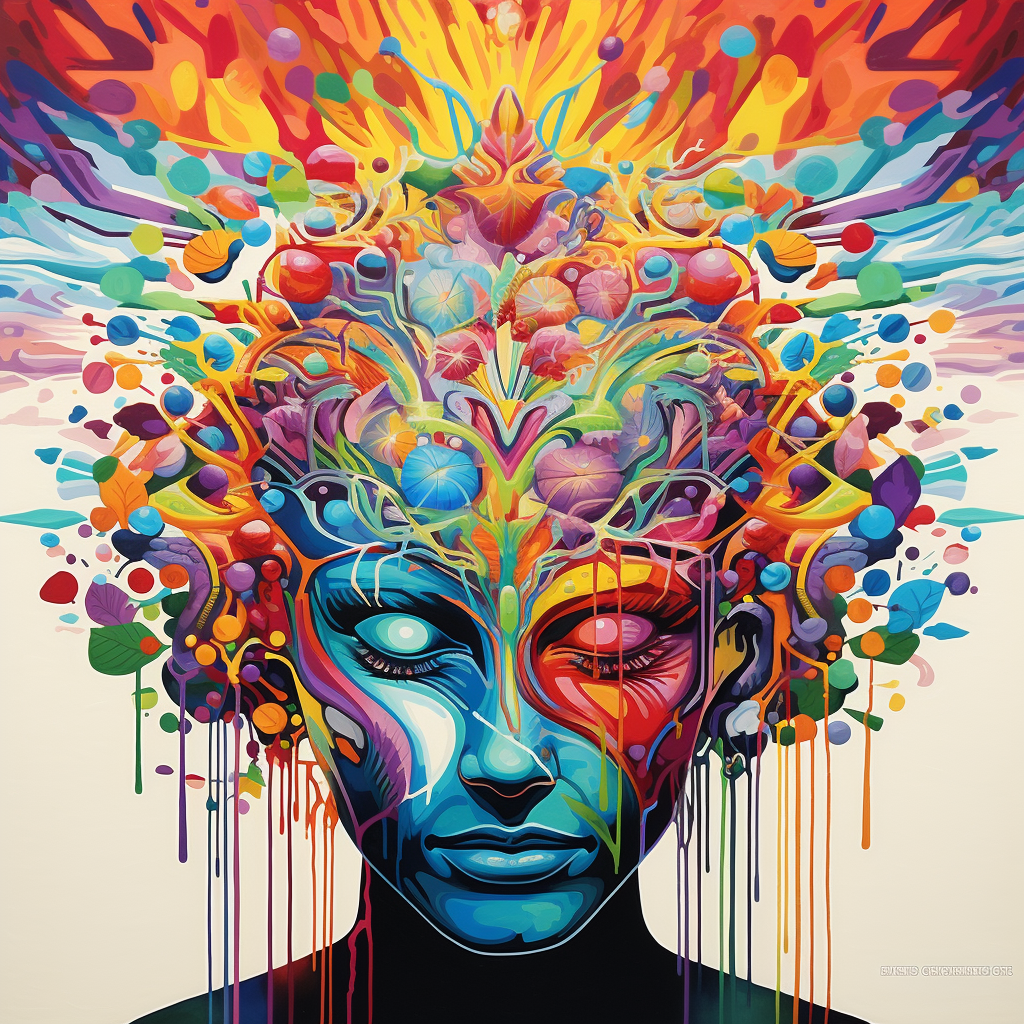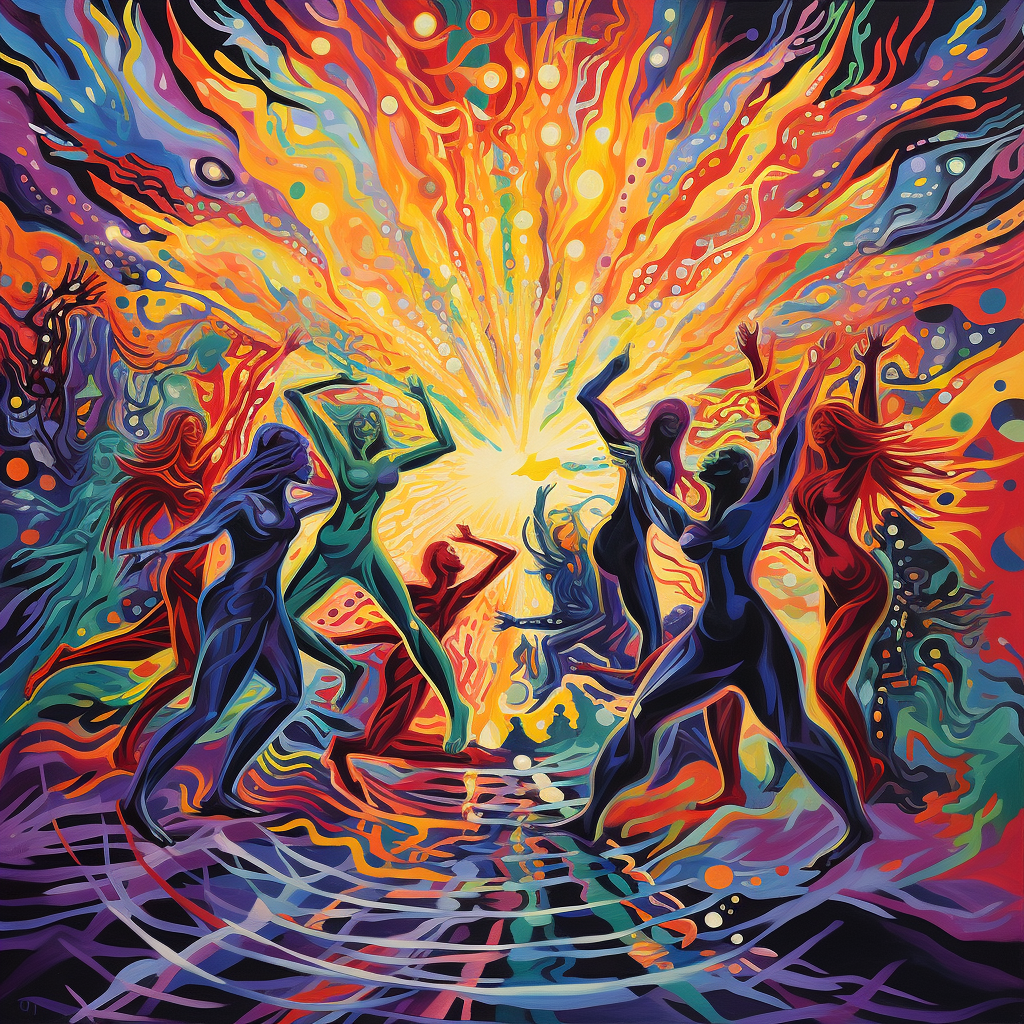We're in Beta 🙃
MDMA
History and Social Significance
Clinical Origins
MDMA, known on the street as Ecstasy or Molly, was initially synthesized in 1912 by the Merck pharmaceutical company in Germany during a quest for substances to control bleeding. However, its psychoactive properties remained largely unnoticed until 1976 when the chemist Alexander Shulgin recognized its potential utility in psychotherapy due to its ability to foster states of empathy and openness.
In the late 1970s and early 1980s, a small cadre of therapists began using the substance alongside couples therapy, and for treating various psychiatric disorders. This therapeutic use continued until 1985 when the Drug Enforcement Administration (DEA) designated it as a Schedule I controlled substance, citing its high potential for abuse and lack of accepted medical safety.
Societal & Cultural Acceptance
Undeterred by prohibition, this psychedelic rose in popularity throughout the late 1980s and 1990s in the rave and club scenes of the era. Soon, it became the poster child of all-night dance parties and electronic dance music. Its empathogenic and euphoric effects resonated well among youth and party-goers, blending seamlessly with the communal atmosphere of these events.
In the early 2000s, the psychedelic received renewed scientific interest, particularly for its potential therapeutic benefits in treating post-traumatic stress disorder (PTSD). This has led to numerous clinical trials, reflecting a broader societal shift towards viewing this and similar psychedelics as potential therapeutic agents, moving away from previous stigmatization and criminalization.
The Chemistry of MDMA
 MDMA, or 3,4-methylenedioxy-N-methylamphetamine, is a synthetic compound derived from safrole, a substance found in various essential oils. It belongs to the phenethylamine and amphetamine families, which explains its stimulant and psychedelic properties.
MDMA, or 3,4-methylenedioxy-N-methylamphetamine, is a synthetic compound derived from safrole, a substance found in various essential oils. It belongs to the phenethylamine and amphetamine families, which explains its stimulant and psychedelic properties.
Structurally, this compound features a core phenethylamine structure along with an additional methyl group attached to the nitrogen atom, distinguishing it from other amphetamines and contributing to its unique pharmacological effects. The presence of the methylenedioxy group on the phenyl ring is crucial for the empathogenic and euphoric effects associated with the substance, as it enhances the release of serotonin, dopamine, and norepinephrine in the brain.
Its chemical configuration facilitates its interaction with neurotransmitter systems, leading to its characteristic effects on mood, perception, and energy, marking it distinct in the realm of psychoactive substances.
How MDMA Affects Your Brain
This psychedelic operates by primarily enhancing the activity of three neurotransmitters: serotonin, dopamine, and norepinephrine. Here's a breakdown of its action:
Serotonin Release: The substance triggers a massive release of serotonin, a neurotransmitter vital for mood regulation, among other functions. The heightened serotonin activity induces feelings of happiness, warmth, and an elevated mood, which are its hallmark effects.
Dopamine and Norepinephrine Release: Simultaneously, this psychedelic compound also stimulates the release of dopamine, which contributes to the euphoria and increased energy, and norepinephrine, which can elevate heart rate and blood pressure.
Reuptake Inhibition: It inhibits the reuptake of these neurotransmitters, prolonging their effects in the synaptic cleft, which is the space between neurons.
Enhanced Emotional Understanding: By augmenting serotonin transmission, this psychedelic enhances emotional empathy and prosocial behavior, which is why it’s being investigated for its potential in psychotherapy, especially for conditions like PTSD (Mithoefer et al., 2019).
Sensory Perception: Although not a classic hallucinogen, MDMA can mildly alter sensory perception and heighten the appreciation of tactile sensations.
Hormonal Effects: It can also trigger the release of hormones like oxytocin and vasopressin, which may underlie feelings of closeness and emotional bonding often reported by users.
Exploring Other Empathogens
Several other substances fall under the empathogen category due to their ability to enhance empathy, openness, and emotional connection.
MDA (3,4-Methylenedioxyamphetamine): Often regarded as a sibling compound, MDA promotes a sense of emotional warmth and interconnectedness. Its effects tend to last longer, and its hallucinogenic properties are often more pronounced.
2C-B (2,5-dimethoxy-4-bromophenethylamine): A synthetic psychedelic often described as a cross between MDMA and LSD, with users reporting enhanced emotional insight and a heightened sense of aesthetics alongside visual distortions.

6-APB (6-(2-aminopropyl)benzofuran): A synthetic substance also known for inducing feelings of empathy, euphoria, and well-being. It also stimulates the release of serotonin, dopamine, and norepinephrine, although its exact mechanism of action and full spectrum of effects are not well understood.
Methylone (βk-MDMA): A synthetic empathogen that induces similar effects such as increased sociability, empathy, and euphoria. It too acts on the serotonin, dopamine, and norepinephrine neurotransmitter systems, although its effects are often reported to be milder.
4-FA (4-Fluoroamphetamine): A synthetic stimulant and empathogen that has been reported to produce effects akin to those of MDMA, though typically milder. It's known for increasing sociability, mood elevation, and enhanced perception of music.

The MDMA Experience
The experience is often described as euphoric, emotionally enriching, and deeply social. Here are common features MDMA users often cite:
Euphoria and Well-Being: People often describe a profound sense of euphoria, well-being, and joy. The world appears brighter, sensations feel more intense, and a general sense of happiness prevails.
Enhanced Social Interaction: social barriers dissolve, rendering interactions with others easier, more meaningful, and deeply empathetic. Users often report feeling a profound sense of connection and understanding towards others.
Heightened Sensory Perception: Music sounds richer, colors appear more vibrant, and tactile sensations are enhanced. The augmentation of sensory perception contributes to its popularity in music and dance settings.
Emotional Openness: Individuals become more open, both emotionally and communicatively. This openness can lead to significant introspective insights and a strong sense of catharsis.
Decreased Anxiety: Anxiety-diminishing effects can facilitate constructive dialogue in therapy and help individuals confront difficult or traumatic issues.
Altered Sense of Time: While not as pronounced as with classic psychedelics, some users report a slowed or altered perception of time.
Physical Stimulation: An increased desire to move, dance, and express oneself physically is common, accompanied by a feeling of boundless energy.
The MDMA experience is unique yet universally cherished for its ability to cultivate a profound sense of connection with oneself, others, and the surrounding world.
The MDMA experience can be described as...
There was no "high," only a sensation of warmth. To my surprise, MDMA put me into a state which felt natural and familiar. I knew this place as meditation, but at a far higher level than I ever achieved in years of nourishing Zen practice.
I feel very different towards people, also. Instead of hating everything and everyone, I now feel great love and compassion for everyone.
The feeling of tenderness and peace helped me to speak of fears that before had been too great to even think about.
For me, it opened my mind to self-love. I understood that I was a good person and worthy of love. I was worthy of loving myself as well as having others love me. I had never contemplated or considered that I was lovable, or worthy of love.
I was able for the first time to feel a space of love for myself.
Trepidations about daily concerns slipped away like one trying to recall a dream shortly after waking up. The concerns of how I saw myself, especially through the eyes of others, were no longer there. But what remained after the self-conscious narrator vanished completely was this energetic sense of pure love and compassion for everything.
The above quoted experiences were selected from firsthand accounts of MDMA’s effects shared on the Multidisciplinary Association for Psychedelic Studies (MAPS) website. You can find all the experiences here.
Can MDMA Help with Severe Mental Health Conditions?
MDMA has garnered substantial attention within the psychiatric community for its potential as a therapeutic aid, particularly in the treatment of post-traumatic stress disorder (PTSD).Post-Traumatic Stress Disorder (PTSD)
Clinical trials have demonstrated promising outcomes in utilizing MDMA-assisted psychotherapy for treating PTSD. By diminishing fear and enhancing emotional insight, MDMA could potentially facilitate the therapeutic processing of traumatic memories.
Anxiety and Depression
The emotional openness and reduced anxiety associated with this psychedelic could offer a valuable tool for individuals grappling with anxiety disorders or depression, fostering a conducive environment for therapy and personal insight.
Autism Spectrum Disorder (ASD)
Some studies suggest it could assist individuals with ASD in managing social anxiety, thereby improving social functioning and interpersonal interactions.
End-of-Life Anxiety
MDMA's capacity to alleviate existential distress has been explored in individuals facing terminal illnesses, aiming to improve their quality of life and ease end-of-life anxiety.
Couples Therapy
Historically, this substance was utilized to enhance communication and emotional disclosure in couples therapy, before its Schedule I classification.
Substance Use Disorders
Although in beginning stages, some research is examining its potential in treating substance use disorders, by addressing underlying trauma and promoting self-reflection.
MDMA's potential to address a range of mental health conditions lies in its ability to create a safe psychological space for individuals to explore and process often challenging emotional terrain.
Its empathogenic and anxiolytic effects, when combined with structured psychotherapeutic support, could offer a novel approach to mental health treatment.
It's important to note that its use in a therapeutic setting is fundamentally different from recreational use, necessitating careful dosing, medical supervision, and a structured therapeutic process to ensure safety and efficacy.
Microdosing: An Alternative Approach


While commonly associated with classic psychedelics like LSD and psilocybin, some people are exploring the benefits of microdosing MDMA. Users report improved mood and energy, increased empathy, reduced anxiety and stress, and subtle enhancements in social interactions while microdosing.
However, the long-term effects of microdosing this psychedelic have not been well studied. Research is sparse and anecdotal. The serotonin-releasing properties of MDMA raise concerns about serotonin syndrome and potential neurotoxicity, especially with frequent use, even at lower doses.
✨ Benefits + Effects of MDMA ✨


Elevated Mood


Enhanced Social


Heightened Sensory


Emotional


Therapeutic


Empathogenic
The Latest Scientific Research on MDMA
MDMA Moves Closer to US Approval Following Success in PTSD Trial
Long-awaited trial data show MDMA is effective at treating post-traumatic stress disorder (PTSD) in a diversity of people, passing another key hurdle on its way to regulatory approval as a treatment for mental illness.
In the largest and most diverse study to date, researchers in this Phase 3 trial found that MDMA — in combination with psychotherapy — can lead to a significant and dramatic reduction in symptoms. At the end of the study, 86.5% of people who received MDMA reported reduced severity of symptoms. 71% improved enough that they no longer even met the diagnostic criteria for PTSD.
The Food and Drug Administration is expected to issue a decision on MDMA-assisted therapy for PTSD in early 2024.
Read the full study published in Nature here.
Perspectives On The Therapeutic Potential Of MDMA: A Nation-Wide Exploratory Survey Among Substance Users
This nationwide survey of people who self-reported criteria consistent with alcohol or substance use disorders aimed to gauge opinions on the research and clinical potential of psychedelic-assisted therapies for PTSD.
This research report examines these potential barriers in a population that stands to benefit greatly from psychedelic therapies for PTSD: individuals that use substances.
Approximately 70% of survey respondents indicated their support for MDMA-based research and belief that MDMA could be useful for treating mental health disorders.The full research report is available at Frontiers in Psychiatry.
MDMA-Assisted Therapy Keeps Gaining Traction
Since the early 2000′s the Multidisciplinary Association for Psychedelic Studies (MAPS) has been spearheading worldwide clinical research of MDMA-Assisted Therapy.
Pooled data from all the MAPS-sponsored Phase 2 trials led to the FDA Breakthrough Therapy designation in 2017 and the expansion into multi-site Phase 3 trials.
In addition to PTSD, MAPS is studying how MDMA-assisted therapy can help with anxiety and eating disorders, and they continue to pioneer the field of psychedelics.
You can track all their research here.
Can MDMA trigger a bad trip?
Known for its euphoric effects, this substance can also trigger negative experiences or "bad trips," influenced by factors like dosage, purity of the substance, and the setting in which it's consumed.
An excessive dose or impurities in street versions can make the experience unpleasant and potentially dangerous. Setting and one’s psychological state play pivotal roles; a stressful environment or troubled emotional state can lead to anxiety and discomfort.
Individual reactions can vastly differ as well, with some individuals prone to anxiety, paranoia, or panic, especially if they are newcomers to the substance or have a sensitivity to stimulants.
Moreover, combining MDMA with other substances can trigger unpredictable and often adverse effects, heightening the likelihood of a negative experience.
After-Effects & Side Effects
The comedown from MDMA can be challenging, manifesting as depression, irritability, or fatigue. For individuals with unresolved trauma or mental health conditions, it could trigger distressing memories or emotions.
Other Possible Side Effects
- Nausea
- Jaw clenching or teeth grinding
- Increased heart rate and blood pressure
- Muscle cramps or tension
- Sweating or chills
- Dehydration
- Hyperthermia (dangerously high body temperature)
- Insomnia
- Fatigue
Safe Dosing Can Be Life-Saving
Safe dosing can significantly reduce the risks associated with serotonin syndrome and overdose. Both conditions are life-threatening and can manifest when excessive amounts of MDMA are ingested.
Overdose symptoms may include high blood pressure, hallucinations, and in severe cases, hyperthermia which can result in organ failure. Serotonin syndrome, on the other hand, arises from an excess of serotonin in the brain, often exacerbated by high doses or combination with other serotonin-influencing substances. Symptoms include confusion, hallucination, and severe muscle stiffness among others.
Adhering to safe dosing guidelines, being aware of the purity of the substance, and avoiding mixing MDMA with other substances can be life-saving measures.
Contraindications for Use
While MDMA has the potential to offer therapeutic and personal benefits, it's not suitable for everyone. Here are some contraindications and considerations regarding use:
- Medication Interactions: It may interact adversely with certain medications, including antidepressants, antipsychotics, and certain cardiovascular medications. Consult a healthcare provider before mixing with other substances.
- Serotonin Reuptake Inhibitors (SSRIs): Combining with SSRIs or other serotonin-modulating medications can lead to serotonin syndrome, a potentially life-threatening condition.
- Cardiovascular Conditions: Patients with cardiovascular conditions like heart disease, hypertension, or arrhythmias should exercise caution since this substance can cause significant elevations in heart rate and blood pressure.
- Psychiatric Conditions: Individuals with a history of psychosis, bipolar disorders, severe anxiety, or other serious psychiatric conditions should avoid this substance as it may exacerbate symptoms or trigger latent psychiatric issues.
- Liver Disorders: Individuals with liver disorders should avoid this substance as it could potentially cause further liver damage.
- Pregnancy and Breastfeeding: This substance is contraindicated in pregnant or breastfeeding women due to the unknown effects on the fetus or infant.
- Alcohol and Other Substances: Mixing with alcohol or other substances can lead to unpredictable effects and increase the risks associated with use.
- Lack of Proper Setting and Guidance: A conducive setting and knowledgeable guidance can help one navigate the experience safely, especially for those with conditions or medications that might interact adversely with this psychedelic.
- Personal Readiness: Considering one's emotional readiness and intent is essential. This and other psychedelics are not a "quick fix" and require a supportive environment for a safe and enriching experience.
The Legal Status of MDMA
Legal Status in the United States
MDMA remains a Schedule I controlled substance federally. This classification denotes that the substance currently holds no accepted medical use and has a high potential for abuse.
However, this status may evolve as ongoing clinical trials demonstrate its therapeutic potential for mental health conditions like post-traumatic stress disorder (PTSD).
Its possession, sale, or manufacture are severely penalized and can result in substantial fines and lengthy prison sentences.
Moreover, the legal implications extend beyond federal law, with state laws also imposing stringent penalties.


International Legal Status
This substance's legal status varies significantly across different countries and regions, reflecting a diverse range of regulatory approaches. Here are some notable examples:
- United Kingdom: Classified as a Class A controlled substance, indicating a high potential for abuse and no recognized medical value. Penalties for possession, distribution, or production are severe.
- Canada: Listed as a Schedule III controlled substance, its unauthorized possession, distribution, or production is subject to criminal penalties.
- Australia: Classified as a Schedule 9 prohibited substance, indicating its use is prohibited except for research purposes under strictly controlled conditions.
- European Union: The legal status and penalties associated with this substance vary among EU member states, though it is generally controlled and criminalized across the EU.
- Netherlands: Despite its liberal drug policies, MDMA is listed as a List I controlled substance, signifying a high risk of harm and addiction.
- Japan: This substance is strictly controlled under Japan’s Narcotic and Psychotropic Drugs Control Law, with severe penalties for unauthorized possession, sale, or manufacture.


















